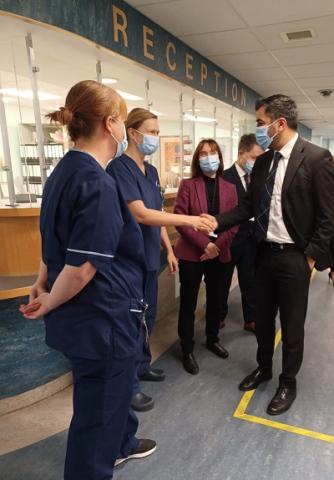
Tayside Emergency Departments are gearing up for winter with a focus on making sure patients get the Right Care in the Right Place.
Supported by a whole team, whole system approach to emergency care and treatment, the consultants and senior doctors at the Flow Navigation Centre (FNC) in the Emergency Department (ED) at Ninewells Hospital have been building on the improvements they have delivered for patients over the past two years. This approach has seen NHS Tayside retain its position as the highest performing mainland Board in Scotland against the four-hour A&E treatment standard.
Tayside’s FNC is set up as a clinical assessment hub - but with a difference. It is staffed by ED consultants and other senior ED clinical decision makers who are available 24/7 to provide professional advice and support to other healthcare professionals such as GPs, staff at NHS 24, colleagues in the Scottish Ambulance Service and nurses in Minor Injury Units. The consultants and senior staff also speak directly to patients on video and phone consultations which allow them to clinically assess the best place for a patient to go to for the most appropriate treatment.
Cabinet Secretary for Health and Social Care Mr Humza Yousaf visited the Ninewells ED today to meet the frontline staff who are leading this approach, which is now seeing around 40,000 calls a year into the hub from healthcare professionals and patients. These professional-to-professional calls and call-backs directly to patients are resulting in over 35% of referrals not having to attend ED at all, with more appropriate care and treatment options provided.
At today’s visit, Dr Alison White, Co-Clinical Lead for NHS Tayside’s Emergency Department explained how the FNC works: “Our clinicians in the FNC respond to around 750 to 800 calls a week from our colleagues in Perth Royal Infirmary ED, Scottish Ambulance Service, NHS 24 and Minor Injury Units as well as speaking directly to patients.
“Our team of clinicians assess patients by video call or over the phone to decide the best next steps for them. It may be that we book the patient into an appointed time slot at the Emergency Department so they don’t have to wait when they come along, or they may be asked to go to another service which is more appropriate for their needs. Of course, some patients are still asked to come directly to ED, but others just need some advice on self-management of their condition and a bit of assurance from a senior clinician that their illness is being treated appropriately.”
Dr Jamie Morrison, Consultant in Emergency Medicine and Clinical Lead for the FNC in Tayside said, “The FNC is one part of a whole system model we use to manage increasing demands on our service. In Tayside, the FNC operates 24 hours a day, seven days a week and we use senior clinicians to rapidly assess patients.
“This means we can ensure that people get the advice about the right care for their need, often avoiding an unnecessary trip to the busy ED. Just over a third of those who are assessed through the FNC do not need to come to ED which frees up the team to deliver emergency care to those who need us most.”
Speaking after his visit, the Health Secretary said, “I was pleased to see first-hand the outstanding work staff at NHS Tayside are carrying out in their Flow Navigation Centre. The service has a crucial role to play in relieving pressure on A&E by directing people to the most appropriate urgent care. My thanks to all staff at NHS Tayside for their continued hard work to make this service so successful with more than 40,000 calls going through the hub last year.
“Flow Navigation Centres are in place right across the country and aim to ensure rapid access to a clinician and scheduled in person, phone or video appointments, to avoid unnecessary long waits.
“If you think you need A&E, but it is not an emergency you can contact NHS 24 where you may be referred on to the virtual A&E. You will get treated faster, and if you do need to visit a physical site for an in person consultation, you may receive an appointment to help avoid any unnecessary waits in A&E.”